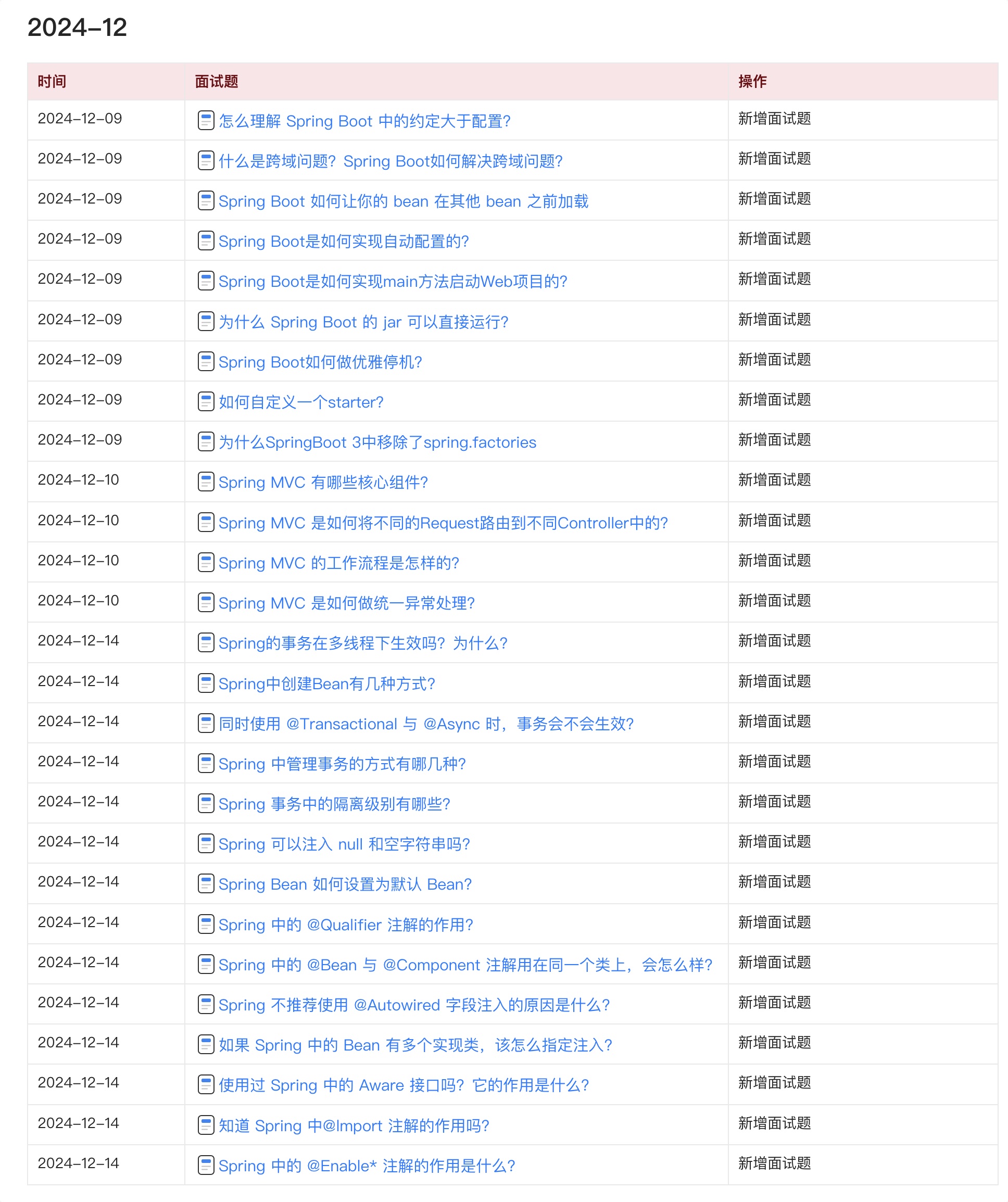概述
前面几篇文章我们一直是在实现SpringCloud体系中的认证功能模块,验证当前登录用户的身份;本篇文章我们来讲SpringCloud体系中的授权功能,验证你是否能访问某些功能。
认证授权
很多同学分不清认证和授权,把他们当同一个概念来看待。其实他们是两个完全不同的概念,举个容易理解的例子:
你是张三,某知名论坛的版主。在你登录论坛的时候输入账号密码登录成功,这就证明了你是张三,这个过程叫做认证(authentication)。登录后系统判断你是版主,你可以给别人发表的帖子加亮、置顶,这个校验过程就是授权(authorization)。
简而言之,认证过程是告诉你你是谁,而授权过程是告诉你你能做什么?
在SpringCloud 体系中实现授权一般使用以下两种方式:
-
基于路径匹配器授权
系统所有请求都会经过Springcloud Gateway 网关,网关收到请求后判断当前用户是否拥有访问路径的权限,主要利用ReactiveAuthorizationManager#check(Mono<Authentication> authenticationMono, AuthorizationContext authorizationContext)方法进行校验。这种方法主要是基于用户 拥有的资源路径 进行考量。
-
基于方法拦截
使用这种方法在网关层不进行拦截,在需要进行权限校验的方法上加上SpringSecurity注解,判断当前用户是否有访问此方法的权限,当然也可以使用自定义注解或使用AOP进行拦截校验,这几种实现方式我们都统称为基于方法拦截。这种方法一般会基于用户 拥有的资源标识 进行考量。
接下来我们分别使用两种不同方式实现SpringCloud 授权过程。
核心代码实现
不管是使用哪种方式我们都得先知道当前用户所拥有的角色资源,所以我们先利用RBAC模型建立一个简单的用户、角色、资源表结构并在项目中建立对应的Service、Dao层。
 (资源表中建立了资源标识和请求路径两个字段,方便实现代码逻辑)
(资源表中建立了资源标识和请求路径两个字段,方便实现代码逻辑)
基于路径匹配器授权
- 改造自定义UserDetailService
还记得我们原来自定义的UserDetailService吗,在loadUserByUsername()方法中需要返回UserDetails对象。之前我们返回的是固定的 'ADMIN' 角色,这里要改成从数据库中获取真实的角色,并将与角色对应的资源都放到UserDetails对象中。
@Override
public UserDetails loadUserByUsername(String userName) throws UsernameNotFoundException {
//获取本地用户
SysUser sysUser = sysUserMapper.selectByUserName(userName);
if(sysUser != null){
//获取当前用户的所有角色
List<SysRole> roleList = sysRoleService.listRolesByUserId(sysUser.getId());
sysUser.setRoles(roleList.stream().map(SysRole::getRoleCode).collect(Collectors.toList()));
List<Integer> roleIds = roleList.stream().map(SysRole::getId).collect(Collectors.toList());
//获取所有角色的权限
List<SysPermission> permissionList = sysPermissionService.listPermissionsByRoles(roleIds);
sysUser.setPermissions(permissionList.stream().map(SysPermission::getUrl).collect(Collectors.toList()));
//构建oauth2的用户
return buildUserDetails(sysUser);
}else{
throw new UsernameNotFoundException("用户["+userName+"]不存在");
}
}
/**
* 构建oAuth2用户,将角色和权限赋值给用户,角色使用ROLE_作为前缀
* @param sysUser 系统用户
* @return UserDetails
*/
private UserDetails buildUserDetails(SysUser sysUser) {
Set<String> authSet = new HashSet<>();
List<String> roles = sysUser.getRoles();
if(!CollectionUtils.isEmpty(roles)){
roles.forEach(item -> authSet.add(CloudConstant.ROLE_PREFIX + item));
authSet.addAll(sysUser.getPermissions());
}
List<GrantedAuthority> authorityList = AuthorityUtils.createAuthorityList(authSet.toArray(new String[0]));
return new User(
sysUser.getUsername(),
sysUser.getPassword(),
authorityList
);
}
注意这里是将SysPermission::getUrl放入用户对应权限中。
- 改造AccessManager实现权限判断
@Autowired
private AccessManager accessManager;
@Bean
SecurityWebFilterChain webFluxSecurityFilterChain(ServerHttpSecurity http) throws Exception{
...
http
.httpBasic().disable()
.csrf().disable()
.authorizeExchange()
.pathMatchers(HttpMethod.OPTIONS).permitAll()
.anyExchange().access(accessManager)
...
return http.build();
}
在原来网关配置中我们注入了自定义的ReactiveAuthorizationManager用于权限判断,我们需要实现根据请求路径与用户拥有的资源路径进行判断,若存在对应的资源访问路径则继续转发给后端服务,负责返回“没有权限访问”。
@Slf4j
@Component
public class AccessManager implements ReactiveAuthorizationManager<AuthorizationContext> {
private Set<String> permitAll = new ConcurrentHashSet<>();
private static final AntPathMatcher antPathMatcher = new AntPathMatcher();
public AccessManager (){
permitAll.add("/");
permitAll.add("/error");
permitAll.add("/favicon.ico");
//如果生产环境开启swagger调试
permitAll.add("/**/v2/api-docs/**");
permitAll.add("/**/swagger-resources/**");
permitAll.add("/webjars/**");
permitAll.add("/doc.html");
permitAll.add("/swagger-ui.html");
permitAll.add("/**/oauth/**");
}
/**
* 实现权限验证判断
*/
@Override
public Mono<AuthorizationDecision> check(Mono<Authentication> authenticationMono, AuthorizationContext authorizationContext) {
ServerWebExchange exchange = authorizationContext.getExchange();
//请求资源
String requestPath = exchange.getRequest().getURI().getPath();
// 是否直接放行
if (permitAll(requestPath)) {
return Mono.just(new AuthorizationDecision(true));
}
return authenticationMono.map(auth -> {
return new AuthorizationDecision(checkAuthorities(auth, requestPath));
}).defaultIfEmpty(new AuthorizationDecision(false));
}
/**
* 校验是否属于静态资源
* @param requestPath 请求路径
* @return
*/
private boolean permitAll(String requestPath) {
return permitAll.stream()
.filter(r -> antPathMatcher.match(r, requestPath)).findFirst().isPresent();
}
/**
* 权限校验
* @author http://www.javadaily.cn
* @param auth 用户权限
* @param requestPath 请求路径
* @return
*/
private boolean checkAuthorities(Authentication auth, String requestPath) {
if(auth instanceof OAuth2Authentication){
Collection<? extends GrantedAuthority> authorities = auth.getAuthorities();
return authorities.stream()
.map(GrantedAuthority::getAuthority)
.filter(item -> !item.startsWith(CloudConstant.ROLE_PREFIX))
.anyMatch(permission -> antPathMatcher.match(permission, requestPath));
}
return false;
}
}
-
测试
 查看当前用户拥有的所有权限
查看当前用户拥有的所有权限 请求正常权限范围内资源
请求正常权限范围内资源 访问没有权限的资源
访问没有权限的资源
基于方法拦截实现
基于方法拦截实现在本文中是基于SpringSecurity内置标签@PreAuthorize,然后通过实现自定义的校验方法hasPrivilege()完成。再强调一遍这里实现方式有很多种,不一定非要采取本文的实现方式。
此方法下的代码逻辑需要写在资源服务器中,也就是提供具体业务服务的后端服务。由于每个后端服务都需要加入这些代码,所以建议抽取出公共的starter模块,各个资源服务器引用starter模块即可。
”
- 改造UserDetailService
改造过程跟上面过程一样,只不过这里是需要将资源标识放入用户权限中。
sysUser.setPermissions(
permissionList.stream()
.map(SysPermission::getPermission)
.collect(Collectors.toList())
);
- 删除网关拦截配置
由于不需要使用网关拦截,所以我们需要将AccessManager中的校验逻辑删除并全部返回true。 - 自定义方法校验逻辑
/**
* 自定义权限校验
* @author http://www.javadaily.cn
*/
public class CustomMethodSecurityExpressionRoot extends SecurityExpressionRoot implements MethodSecurityExpressionOperations {
private static final AntPathMatcher antPathMatcher = new AntPathMatcher();
public CustomMethodSecurityExpressionRoot(Authentication authentication) {
super(authentication);
}
private Object filterObject;
private Object returnObject;
public boolean hasPrivilege(String permission){
Collection<? extends GrantedAuthority> authorities = authentication.getAuthorities();
return authorities.stream()
.map(GrantedAuthority::getAuthority)
.filter(item -> !item.startsWith(CloudConstant.ROLE_PREFIX))
.anyMatch(x -> antPathMatcher.match(x, permission));
}
...
}
- 自定义方法拦截处理器
/**
* @author http://www.javadaily.cn
*/
public class CustomMethodSecurityExpressionHandler extends DefaultMethodSecurityExpressionHandler {
private AuthenticationTrustResolver trustResolver = new AuthenticationTrustResolverImpl();
@Override
protected MethodSecurityExpressionOperations createSecurityExpressionRoot(
Authentication authentication, MethodInvocation invocation) {
CustomMethodSecurityExpressionRoot root =
new CustomMethodSecurityExpressionRoot(authentication);
root.setPermissionEvaluator(getPermissionEvaluator());
root.setTrustResolver(this.trustResolver);
root.setRoleHierarchy(getRoleHierarchy());
return root;
}
}
- 启用方法校验
@Configuration
@EnableGlobalMethodSecurity(prePostEnabled = true)
public class MethodSecurityConfig extends GlobalMethodSecurityConfiguration {
@Override
protected MethodSecurityExpressionHandler createExpressionHandler() {
CustomMethodSecurityExpressionHandler expressionHandler =
new CustomMethodSecurityExpressionHandler();
return expressionHandler;
}
}
- 在需要权限校验的方法上加上注解
@ApiOperation("select接口")
@GetMapping("/account/getByCode/{accountCode}")
@PreAuthorize("hasPrivilege('queryAccount')")
public ResultData<AccountDTO> getByCode(@PathVariable(value = "accountCode") String accountCode){
log.info("get account detail,accountCode is :{}",accountCode);
AccountDTO accountDTO = accountService.selectByCode(accountCode);
return ResultData.success(accountDTO);
}
-
测试
 通过debug可以看到这里获取到的用户权限是资源表中的资源标识。
通过debug可以看到这里获取到的用户权限是资源表中的资源标识。
小结
个人觉得在SpringCloud微服务架构中最复杂的一个模块就是用户的认证授权模块,本文通过两种实现方法解决了授权问题,解决你能做什么的问题。
大家可以根据实际业务场景选择具体的实现方式,当然了个人还是建议使用第一种基于路径匹配器授权的方式,只需要在网关层进行拦截即可。
Java 面试宝典是大明哥全力打造的 Java 精品面试题,它是一份靠谱、强大、详细、经典的 Java 后端面试宝典。它不仅仅只是一道道面试题,而是一套完整的 Java 知识体系,一套你 Java 知识点的扫盲贴。
它的内容包括:
- 大厂真题:Java 面试宝典里面的题目都是最近几年的高频的大厂面试真题。
- 原创内容:Java 面试宝典内容全部都是大明哥原创,内容全面且通俗易懂,回答部分可以直接作为面试回答内容。
- 持续更新:一次购买,永久有效。大明哥会持续更新 3+ 年,累计更新 1000+,宝典会不断迭代更新,保证最新、最全面。
- 覆盖全面:本宝典累计更新 1000+,从 Java 入门到 Java 架构的高频面试题,实现 360° 全覆盖。
- 不止面试:内容包含面试题解析、内容详解、知识扩展,它不仅仅只是一份面试题,更是一套完整的 Java 知识体系。
- 宝典详情:https://www.yuque.com/chenssy/sike-java/xvlo920axlp7sf4k
- 宝典总览:https://www.yuque.com/chenssy/sike-java/yogsehzntzgp4ly1
- 宝典进展:https://www.yuque.com/chenssy/sike-java/en9ned7loo47z5aw
目前 Java 面试宝典累计更新 400+ 道,总字数 42w+。大明哥还在持续更新中,下图是大明哥在 2024-12 月份的更新情况:

想了解详情的小伙伴,扫描下面二维码加大明哥微信【daming091】咨询

同时,大明哥也整理一套目前市面最常见的热点面试题。微信搜[大明哥聊 Java]或扫描下方二维码关注大明哥的原创公众号[大明哥聊 Java] ,回复【面试题】 即可免费领取。

